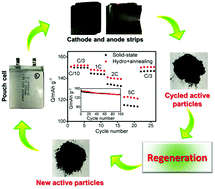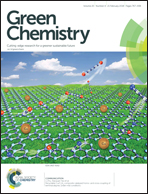Effective regeneration of LiCoO2 from spent lithium-ion batteries: a direct approach towards high-performance active particles†
Abstract
With the growing applications of lithium-ion batteries (LIBs) in many areas, their recycling becomes a necessary task. Although great effort has been made in LIB recycling, there remains an urgent need for green and energy-efficient approaches. Here we report a non-destructive approach to regenerate cathode materials by hydrothermal treatment of cycled electrode particles followed by short annealing. Unlike the conventional chemical leaching or solid-state synthesis approach, which either requires complicated steps of leaching, precipitation and waste treatment or relies on the chemical analysis of the Li/Co ratio from cell to cell, our non-destructive approach is much simpler and more environmentally friendly, and can easily process batteries with different capacity degradation conditions. In addition, the regenerated LiCoO2 particles can retain their original morphology and structure, and provide high specific capacity and cycling stability. Importantly, they show much better rate capability than particles regenerated through the solid-state synthesis approach. Our work demonstrates a greener, simpler and more energy-efficient strategy to recycle and regenerate faded LiCoO2 cathode materials with high electrochemical performance. This approach can be widely used to recycle and regenerate LiCoO2 cathodes on a large scale, and can be potentially applied to other types of cathode materials in LIBs and mixed cathode chemistry.



 Please wait while we load your content...
Please wait while we load your content...